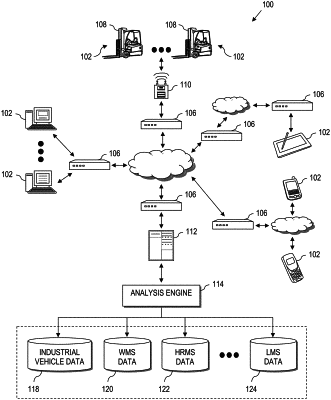| CPC G09B 19/16 (2013.01) [G06Q 10/0639 (2013.01); G06Q 10/06398 (2013.01); G09B 5/00 (2013.01)] | 18 Claims |

|
1. A computer-implemented process for providing dynamic industrial vehicle monitoring for modification of vehicle operator behavior, the process comprising:
receiving by a processor on an industrial vehicle, an operator identification identifying a vehicle operator that has logged onto the industrial vehicle;
loading into a memory accessible by the processor, a metric that characterizes an event associated with the vehicle operator of the industrial vehicle, the metric having a performance parameter to evaluate against the event and a behavior modification action that educates the vehicle operator as to a necessary behavior to reach a desired outcome in response to the event;
monitoring operation of the industrial vehicle by processing code to detect conditions from information obtained across a vehicle network bus of the industrial vehicle that identifies an occurrence of the event characterized by the metric; and
performing, in response to detecting the occurrence of the event:
recording into memory, event data that characterizes a response of the vehicle operator to the event;
evaluating the recorded event data against the performance parameter loaded into memory, which is associated with the corresponding metric;
updating a count of successive correct behaviors where the vehicle operator demonstrated a desired vehicle operator behavior in response to the event;
transitioning the vehicle operator from a first mode designating that the vehicle operator is not trained to respond to the event, to a second mode designating that the vehicle operator is trained to respond to the event, where the count of successive correct behaviors in response to the event satisfies a predetermined condition;
computing a vehicle operator score based upon the evaluation;
linking the computed vehicle operator score with the vehicle operator that had logged onto the industrial vehicle;
performing the behavior modification action when the vehicle operator is in the first mode; and
performing when the vehicle operator is in the second mode:
not implementing the behavior modification action where the vehicle operator demonstrated the desired vehicle operator behavior in response to the event;
providing a warning of an incorrect behavior where the vehicle operator did not demonstrate the desired vehicle operator behavior in response to the event; and
transitioning to the first mode where a frequency of incorrect behavior in response to the event exceeds a threshold;
wherein:
performing the behavior modification action comprises controlling at least one of an output device or controller on the industrial vehicle to electronically convey to the vehicle operator, the necessary behavior to reach the desired outcome.
|